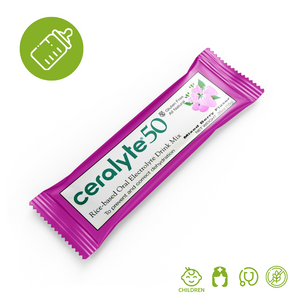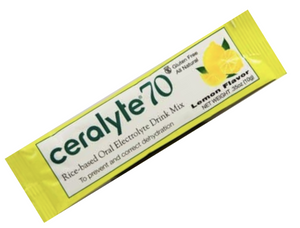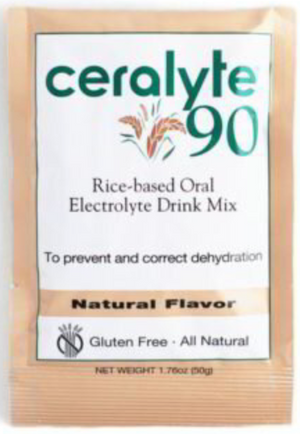


Ceralyte Rice-based Oral Rehydration Solution
-
- Highly effective, fast energy absorption to maintain hydration and plasma volume
- Corrects electrolyte deficiencies and reduces diarrhea
- Rice-based ORS products superior to glucose-based ones for energy and fluid absorption
- WHO recommends rice-based over glucose-based ORS
- Highly effective against infant and childhood cholera and E. Coli dysenteries; reduces diarrhea by 20%, helps preserve weight
- Gluten-free and low in FODMAPS
- Non-transgenic and effective in high ambient temperatures
- Used by the U.S. Military since 1999
- Safe for pregnant women and babies
- No artificial colors or flavorings
- Shelf life 5 years
- Formulas are certified by the renowned Monash University in Australia
Faster Rehydration for Patients using Rice-based ORS
In cases of maternal dehydration due to nausea and vomiting of pregnancy or infectious diarrhea, rice-based ORS have been proven superior over glucose-based or amino acid-based ones. Besides ambient heat, pregnancy is a thermogenic condition that necessitates adequate hydration. The blood volume of pregnant women increased by 50% and requires continual hydration. Water and other beverages may not be adequate, especially if the pregnant woman is experiencing nausea and vomiting or diarrhea.
According to Moore et al. (2016), “The longer CHO (carbohydrate) chains in rice-based ORS may allow more of the CHO to be absorbed by the ileum, resulting in a more sustained release of glucose, energy support, as well as cognitive function in cases of high external heat. They also support water retention to maintain blood volume.
Rice-based ORS, such as Ceralyte, are more efficient and faster at controlling diarrhea from infectious causes such as E. coli and cholera. In some cases, the diarrhea is reduced by 20-30%, and severe weight loss is prevented. Furthermore, long-chain carbohydrates enhance ORS, specifically in cases where watery diarrhea is a primary symptom. Diarrhea of any sort is detrimental to pregnant women and babies. Dehydration can trigger early contractions and contribute to premature births. Premature babies are at risk for numerous serious complications and are not equipped to fight off many types of infection, especially diarrhea. These starch and protein-based ORS, such as Ceralyte, improve rehydration efforts and speed recovery from fluid and nutrient loss.
Short of IV hydration and nutrient supplementation, ORS are critical when resources are scarce.
Product Ordering Information
Our product line includes:
- Ceralyte 50 Potassium-Free
- Ceralyte 50 for Mild and Pediatric Hydration
- Ceralyte 70 for Moderate Dehydration
- Ceralyte 90 for Severe Dehydration
Made in the USA
FAQs
Why Were Rice-Based ORS Developed?
Glucose and amino acid-based ORS were developed initially to combat dehydration from extreme heat and diarrheal illnesses without needing hospitalization. However, research indicates that newer formulations that are rice-based (starch and protein) stabilize electrolytes and glucose faster and more efficiently and have been more effective at reducing diarrhea. Other ORS formulas do not hydrate well or have negative side effects. ORS made with fructose are poorly absorbed and do not use the sodium-glucose cotransporter (SGLT). ORS made with simple sugars move electrolytes through the small intestine very quickly, without electrolyte absorption.
How is Ceralyte Different from other ORS?
ORS like Pedialyte, Gatorade, and other glucose-based ORS do not contain starch and longer chain carbohydrates like Ceralyte products. These components facilitate gastric emptying and higher absorption rates in the gastrointestinal tract, which in turn, stabilize glucose levels and restore blood volume (hydration). In case of extreme heat exposure and diarrheal illnesses that deplete volume, electrolytes, and nutrients, rice-based ORS again proves superior over traditional ORS. There will be less weight loss from diarrhea and less cognitive issues from dehydration due to extreme heat. In the case of pregnancy and infants, both of these issues must be addressed quickly to avoid complications such as premature labor and failure to thrive.
How Does Ceralyte Work?
Ceralyte restores blood volume, glucose, and electrolytes in the case of dehydration for any reason, especially heat exhaustion, diarrhea, and nausea and vomiting. It does this because rice is a starch or fiber that contains long-chained carbohydrates rather than simple sugars. Rice-based ORS help heal inflammation in the GI tract and resorb salts and water more quickly based on clinical studies. These formulations have low osmolality, which means that water is preferentially resorbed into the bloodstream rather than being drawn into the intestines–thus worsening diarrhea.
Usual Dose
Start with 200 ml of water (one 10g packet) after every loose stool, continue until diarrhea stops. May also be used to replace fluids from vomiting with small sips of fluid.
References
- Field M. New strategies for treating watery diarrhea. N.Engl.J.Med 1997; 297(20):1121-22.
-
Rice-Based Electrolyte Drinks More Effective Than Water in Replacing Sweat Losses During Hot Weather Training and Operations. Gerold KB, Greenough WB, III, Yasar S. J Spec Oper Med. 2013 Winter;13(4):12-4.
-
From Cholera to Burns: A Role for Oral Rehydration Therapy. Milner SM, Greenough WB, HI, Asuku ME, Feldman M, Makam R, Noppenberger D, Price LA, Prosciak M, van Loon IN. J Health Popul Nutr. 2011 Dec; 29(6): 648-651.
Where is the price?
Pricing is based on shipping location and the number of units ordered. To request a price, please use the Request a Quote button below. A sales representative will respond to you quickly.
- Highly effective, fast energy absorption to maintain hydration and plasma volume
- Corrects electrolyte deficiencies and reduces diarrhea
- Rice-based ORS products superior to glucose-based ones for energy and fluid absorption
- WHO recommends rice-based over glucose-based ORS
- Highly effective against infant and childhood cholera and E. Coli dysenteries; reduces diarrhea by 20%, helps preserve weight
- Gluten-free and low in FODMAPS
- Non-transgenic and effective in high ambient temperatures
- Used by the U.S. Military since 1999
- Safe for pregnant women and babies
- No artificial colors or flavorings
- Shelf life 5 years
- Formulas are certified by the renowned Monash University in Australia
Faster Rehydration for Patients using Rice-based ORS
In cases of maternal dehydration due to nausea and vomiting of pregnancy or infectious diarrhea, rice-based ORS have been proven superior over glucose-based or amino acid-based ones. Besides ambient heat, pregnancy is a thermogenic condition that necessitates adequate hydration. The blood volume of pregnant women increased by 50% and requires continual hydration. Water and other beverages may not be adequate, especially if the pregnant woman is experiencing nausea and vomiting or diarrhea.
According to Moore et al. (2016), “The longer CHO (carbohydrate) chains in rice-based ORS may allow more of the CHO to be absorbed by the ileum, resulting in a more sustained release of glucose, energy support, as well as cognitive function in cases of high external heat. They also support water retention to maintain blood volume.
Rice-based ORS, such as Ceralyte, are more efficient and faster at controlling diarrhea from infectious causes such as E. coli and cholera. In some cases, the diarrhea is reduced by 20-30%, and severe weight loss is prevented. Furthermore, long-chain carbohydrates enhance ORS, specifically in cases where watery diarrhea is a primary symptom. Diarrhea of any sort is detrimental to pregnant women and babies. Dehydration can trigger early contractions and contribute to premature births. Premature babies are at risk for numerous serious complications and are not equipped to fight off many types of infection, especially diarrhea. These starch and protein-based ORS, such as Ceralyte, improve rehydration efforts and speed recovery from fluid and nutrient loss.
Short of IV hydration and nutrient supplementation, ORS are critical when resources are scarce.
Product Ordering Information
Our product line includes:
- Ceralyte 50 Potassium-Free
- Ceralyte 50 for Mild and Pediatric Hydration
- Ceralyte 70 for Moderate Dehydration
- Ceralyte 90 for Severe Dehydration
Made in the USA
FAQs
Why Were Rice-Based ORS Developed?
Glucose and amino acid-based ORS were developed initially to combat dehydration from extreme heat and diarrheal illnesses without needing hospitalization. However, research indicates that newer formulations that are rice-based (starch and protein) stabilize electrolytes and glucose faster and more efficiently and have been more effective at reducing diarrhea. Other ORS formulas do not hydrate well or have negative side effects. ORS made with fructose are poorly absorbed and do not use the sodium-glucose cotransporter (SGLT). ORS made with simple sugars move electrolytes through the small intestine very quickly, without electrolyte absorption.
How is Ceralyte Different from other ORS?
ORS like Pedialyte, Gatorade, and other glucose-based ORS do not contain starch and longer chain carbohydrates like Ceralyte products. These components facilitate gastric emptying and higher absorption rates in the gastrointestinal tract, which in turn, stabilize glucose levels and restore blood volume (hydration). In case of extreme heat exposure and diarrheal illnesses that deplete volume, electrolytes, and nutrients, rice-based ORS again proves superior over traditional ORS. There will be less weight loss from diarrhea and less cognitive issues from dehydration due to extreme heat. In the case of pregnancy and infants, both of these issues must be addressed quickly to avoid complications such as premature labor and failure to thrive.
How Does Ceralyte Work?
Ceralyte restores blood volume, glucose, and electrolytes in the case of dehydration for any reason, especially heat exhaustion, diarrhea, and nausea and vomiting. It does this because rice is a starch or fiber that contains long-chained carbohydrates rather than simple sugars. Rice-based ORS help heal inflammation in the GI tract and resorb salts and water more quickly based on clinical studies. These formulations have low osmolality, which means that water is preferentially resorbed into the bloodstream rather than being drawn into the intestines–thus worsening diarrhea.
Usual Dose
Start with 200 ml of water (one 10g packet) after every loose stool, continue until diarrhea stops. May also be used to replace fluids from vomiting with small sips of fluid.
References
- Field M. New strategies for treating watery diarrhea. N.Engl.J.Med 1997; 297(20):1121-22.
-
Rice-Based Electrolyte Drinks More Effective Than Water in Replacing Sweat Losses During Hot Weather Training and Operations. Gerold KB, Greenough WB, III, Yasar S. J Spec Oper Med. 2013 Winter;13(4):12-4.
-
From Cholera to Burns: A Role for Oral Rehydration Therapy. Milner SM, Greenough WB, HI, Asuku ME, Feldman M, Makam R, Noppenberger D, Price LA, Prosciak M, van Loon IN. J Health Popul Nutr. 2011 Dec; 29(6): 648-651.





